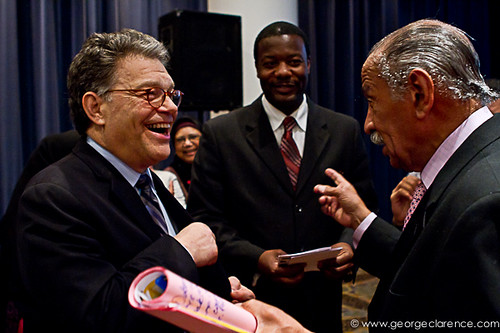 |
| Senator Al Franken and Representative John Conyers, Jr |
“We reintroduced this legislation because of the dangers that the women and men who care for us in our most trying times face on a daily basis,” said Rep. John Conyers. “H.R. 4266, the Nurse and Health Care Worker Protection Act would ensure that those men and women are adequately protected from injuries caused by lifting and moving patients and other related job hazards. By literally lightening the burden on nurses, we can lessen the nursing shortage that is driving up health care costs across the country and denying patients the experienced caregivers they deserve.”
“Our nurses and health care workers provide essential care to millions of Americans, and they shouldn’t have to sacrifice their safety or their livelihood to do so,” Sen. Franken said. “Every year, thousands of these caregivers sustain serious injuries as a result of manually lifting patients. These injuries can cause a lifetime of chronic pain and even force nurses to leave the profession permanently. Our bill would ensure that nurses and health care workers have the tools they need to do their jobs safely, which would prevent injuries, increase patient safety, and reduce costs.”
“Too often we take nurses for granted, but we rely on the invaluable services they provide. Nurses literally do the heavy lifting when it comes to patient care and deserve systems designed to protect their health and safety. This legislation would help reduce the sometimes career-ending injuries that are completely avoidable,” said Rep. Wilson.
The Nurse and Health Care Worker Protection Act of 2015 addresses the problems confronting nurses by requiring the Occupational Safety and Health Administration (OSHA) to promulgate a health and safety standard. That standard would require the use of mechanical lifts and safe lifting practices to minimize the risk of injury.
Presently, nurses and health care workers suffer from work-related musculoskeletal disorders (MSDs) at a rate much higher than the average American worker. In 2014, registered nurses ranked sixth in the number of days away from work because of such injuries, with more than 11,300 total cases; nursing assistants ranked second, with over 20,000. While alarming, these numbers actually reflect the innovative efforts of states that already regulate patient lifting and the hospitals that recognize the cost-effective returns of investing in safe patient lifting programs.
Despite some progress, there are still far too many nurses injured on the job while lifting patients. Those injuries lead to nurses exiting the profession, upending their lives because they can no longer perform their job. Those injuries can also generate increased costs for the health care industry, which must cover lost wages and medical fees for injured health care workers, and train replacements who lack the institutional knowledge lost with each injury.
This proposed standard would build upon the success of similar reforms adopted at the state and individual health care facility level, which has already demonstrated the technological and economic feasibility of such approaches. Hospitals and other health care providers have repeatedly demonstrated a quick return when they invest in safe patient handling programs, recovering their investment through decreased workers’ compensation costs, employee retention savings, and reduced patient care expenses. By standardizing this policy across the nation, the Nurse and Health Care Worker Protection Act will alleviate burdens on health care facilities, nursing training programs, and worker’s compensation agencies.
This bill has the support of key organizations that have long-sought reforms for nurses and health care workers. Randi Weingarten, President of the American Federation of Teachers (AFT), said, “Nurses and other healthcare workers put their patients first. Sometimes, these workers get physically hurt by helping the people they care for. This bill provides a wonderful solution for patients, nurses and other healthcare workers by creating a federal standard on safe patient handling, mobility and injury prevention. As the nation’s second-largest nurses union, the AFT supports Sen. Franken and Rep. Conyers’ efforts to give our members a safe healthcare environment in which they can do what they do best—provide the highest-quality of care for their patients.”
The American Nurses Association (ANA) President Pamela F. Cipriano, PhD, RN, NEA-BC, FAAN commends Rep. Conyers and Sen. Franken for the introduction of the Nurse and Health Care Worker Protection Act. “Every day, nurses and other health care workers suffer debilitating and often career-ending musculoskeletal disorders when they manually lift or move patients, and work in pain. Manual lifting is an unacceptable risk and practice when we have the technology and knowledge to significantly reduce injuries. This bill signals that workers are not expendable and injuries are not tolerable as just ‘part of the job.’ It is a much needed step in the right direction to implementing safer programs that will help tosave and extend the careers of thousands of registered nurses,” said Cipriano, noting that safe lifting technology and simple devices also prevent injuries to patients and preserve their dignity.
Sen. Franken—who serves as ranking member of the Subcommittee on Employment and Workplace Safety—has fought to improve safety for American workers since joining the Senate. He first introduced legislation to implement safe patient handling procedures in 2009, and earlier this year he introduced the Protecting American Workers Act to expand the number of safe workplaces and make it harder to violate workplace safety laws.
Voting is beautiful, be beautiful ~ vote.©
No comments:
Post a Comment